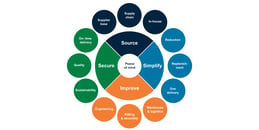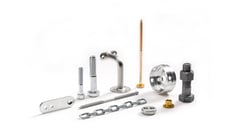- Insights
- The Solutionists Hub
- How to Fulfil Your Sustainability Policy in C-Parts Purchasing
How to Fulfil Your Sustainability Policy in C-Parts Purchasing

Sustainability is a major priority for manufacturing companies, and more and more are creating concrete plans by implementing sustainability policies. If you work with purchasing at one of these companies, you are probably already aware of the sustainability policy, which may have already impacted your work. The supply chain represents a large proportion of a company’s total emissions, so you can make serious improvements by prioritizing where and how you purchase your C-parts.
Soon, sustainability will be a significant contributing factor to a company's success. New regulations, changing customer expectations and pressure from shareholders will make it harder and more expensive to act unsustainably. In this journey towards sustainability, all areas of the company will need to contribute and play their part – starting with the top leadership and extending through production, planning, logistics, distribution and R&D. For some manufacturing companies, it will not be enough to make small changes in certain parts of the operation – instead, a foundational change in the way the company functions will be required.
The purchasing department is a relatively small part of the overall system, but it has an important contribution to make. A company can never be truly sustainable if its suppliers are not also committed to sustainability. With their high level of direct contact with suppliers, purchasers can help develop and push suppliers in the right direction.
In this article, you can see the main actions that you can take to ensure your company's sustainability policy is followed and its targets are met. Some of them are more challenging, and they may involve a learning curve for some companies that have not actively worked with sustainability before – but all of them have the potential to create positive change in your organization.
Set sustainability-related KPIs and goals
Key performance indicators (KPIs) and goals are essential to any improvement initiative. As Maria Götesson explains in this article, KPIs are vital in C-parts purchasing for keeping track of your current performance and prioritizing the improvements you want to make. The same applies to your sustainability work. Without clear targets to aim for, your sustainable purchasing work will suffer from a lack of direction. Your company's overall sustainability policy likely contains broad targets, but to figure out the specific sustainability KPIs and goals for your department, work with purchasing colleagues to specify which ones are feasible with your current supplier base and supply chain. Some sustainability-related KPIs that other companies make use of in their purchasing work include:
- Carbon emissions generated in the production facility, by suppliers, and in the supply chain
- Levels of energy and water consumption during the production process
- Social conditions for the workers within the supply chain
- The proportion of C-parts suppliers who have had an independent sustainability audit in the recent past
For more examples of sustainability KPIs and how they can push your overall sustainability efforts forwards, read this article: Sustainability Targets and KPIs to Implement in the Purchasing Department
Work with a supply chain partner to measure emissions
Carbon emissions get a lot of attention when manufacturers talk about sustainability, and for good reason. The manufacturing and construction sectors stood for over 12 percent of global greenhouse gas emissions in 2019 according to figures from Climate Watch, so sustainability improvements in manufacturing have the potential to make a powerful difference to the environment. Additionally, emissions can be measured in straightforward metrics such as metric tons of carbon dioxide equivalent (mtCO2e), which are highly trackable and comparable across different countries, companies and industries.
However, even if greenhouse gas emissions are easy to understand, they are not easy to calculate, especially in complex C-parts supply chains. To figure out the total emissions generated by your company, you also need to consider scope three emissions. These are emissions that your company does not directly produce or control but indirectly generates through your business activities. Calculating these emissions means looking at the emissions caused in every part of your supply chain, from the raw materials to the production of the C-parts you purchase to the shipping process that gets them to your factory.
Pulling all these figures together is a major challenge, even for major manufacturers with large, dedicated sustainability departments. For that reason, many break the journey down into steps by focusing only on calculating emissions from the most significant suppliers before moving on to the others. Regardless of their chosen method, many companies benefit from getting help from a partner who works exclusively with supply chains and can do the labor-intensive work of calculating total emissions, leaving more time for the manufacturer to focus on strategic sustainability work.
Engage your C-parts suppliers in your sustainability work
As mentioned above, a large quantity of your total emissions are scope three emissions, which lie outside your direct control and are generated chiefly in your supply chain. A 2016 McKinsey report found the supply chain stands for around 80% of a typical manufacturer's total emissions, so it is crucial to make improvements here if you want to make a real difference. To do this, it is not enough to ensure your operation is as sustainable as possible – you must also engage your suppliers.
Education and active support are vital to improving your suppliers' sustainability work and making your overall supply chain more sustainable. Sustainability is an important topic in business, but many companies still do not understand what it means for them or how it will affect their way of working. For this reason, it is not enough to simply present a supplier with a list of demands and expect them to follow them. Some companies have seen success by using tools like webinars and digital Q&A sessions to raise awareness among their suppliers, before moving on and encouraging them to start reporting emissions and setting their own targets. This is a long-term process, but it has the benefit of improving the sustainability of your supply chain, strengthening your relationship with your suppliers, and improving their competitiveness and market position going forward.
If your company lacks the internal knowledge or resources to do this itself, it may be time to consider cooperating with a supply chain partner, who can do the work of developing and educating suppliers for you.
Communicate achievements and successes
Sustainability has been on the agenda for manufacturing companies for a long time, but in the near future, a genuine commitment to sustainability will be essential for success. New regulations will make it harder for companies to act unsustainably, and for more and more potential customers, sustainability will be a deciding factor when looking for a supplier.
Therefore, every step your company takes toward environmental, social and economic sustainability is worth celebrating. Drawing attention to your progress in this way will help colleagues across the company see the extent of the sustainability work being done and may inspire them to take a more serious approach to sustainability in their area of the company.
Furthermore, customers, shareholders and other stakeholders outside the organization will view this information very positively. And as more and more customers measure their partners’ sustainability performance in the same way they measure quality or delivery, becoming a top performer in the sustainability space could mean more business for your company.
Get more guidance on combining sustainability and C-parts
If you're a manufacturer, you're likely facing some urgent sustainability targets. If you're unsure how your C-parts operation can contribute to achieving your overall sustainability goals, take a look at these resources for more input:
- Sustainable C-Parts: A Guide for Purchasers - An overview of the basics around supply chain sustainability, where C-parts fit in, and how your C-parts should be organized to ensure a sustainable operation.
- The Manufacturer's Guide to Sustainability Trends - Sustainability is becoming a key topic for manufacturing companies, and this downloadable presentation explains the sustainable trends you will soon have to deal with. Download it below.
Get new knowledge every week!
Related
-
By Sergio BrambilaSustainability targets and KPIs to implement in the purchasing department
-
By Kadi MeriväljaC-Parts Purchasing: Handling Your Sustainable Purchasing Policy
-
By Patrik Lundström TörnquistSustainability Challenges With C-Parts, and How to Manage Them
-
By Carina LööfSustainable C-Parts: What You Need to Know
-
By Niklas LindsköldCBAM: How will it affect European manufacturers?
-
By Niklas LindsköldHuman rights due diligence: Is your supply chain under control?
-
By Niklas LindsköldChemical compliance: What manufacturing companies need to know
-
By Niklas LindsköldConflict minerals: How to avoid them in your manufacturing operation










